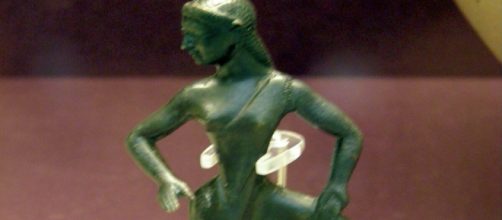How many of you are fans of Wonder Woman, a.k.a. Diana? Not many, most likely. After all, you’re all adults and she is one of those superheroes originating in DC comic books. That’s how I’ve known her even as a devotee since childhood. Kid stuff, yes, and admittedly never outgrown.
But wait, is it kid stuff? News this week can have us all wondering if Diana’s childhood, described in the 2017 Wonder Woman movie, is total fiction. The scenes show how little Diana as the daughter of Queen Hippolyta, is raised and trained as an athlete on the hidden island of Themyscira where women warriors known as the Amazons lived, created by the Olympian gods to protect mankind.
Archaeology news
Get this. Archaeologists have found that women in ancient times didn’t take a back seat in a man’s world as they routinely do in modern civilizations. They were trained athletes who competed publicly with one another and with men, too.
An Artnet report tells how six archaeologists found evidence that women were key players in ancient Greece and Rome. Evidence includes statuettes made of bronze depicting the women of Sparta as popular athletes.
This discovery doesn’t apply to the women of Greece on the mainland. Only those of Sparta were conditioned from childhood in state-supervised programs to be warriors. This early training conjures up the training seen in the 2017 movie "Wonder Woman." Given this archaeological news, the fictional comic book character turns actual.
The evidence
The archaeologists unearthed 40 such statuettes dating back to the Archaic Period circa 6th century B.C. The figurines describe running women captured in mid-sprint “lifting the hems of their tunics to expose a firm upper leg,” says Artnet. For this action, these women were known as “thigh flashers.” And owing to this particular culture of female athleticism, the contour of these sculptures is slender and muscled, unlike the full figures of the better known ancient Greek sculpture of women.
Coins of the realm
Besides sculptures, the archaeologists found bronze coins that also tell the story of these wonder-women. As Artnet tells it, one coin issued in 1st century B.C. inscribed Mineia is a “rare commemoration of a female citizen in Ancient Rome.” In our contemporary society, the chance of seeing, say, Kamala Harris on any American currency is unimaginable.
Then, in a story unrelated to the archaeology find comes this reported in the New York Times saying that anthropologists in Poland discover through X-rays that an Egyptian mummy, long-thought to be that of a priest, is that of a woman pregnant with a fetus 26-30 weeks old.
Re-writing history
The Times story did not make a connection to the Artnet story, but a connection can be made. The mummified woman lived in the 1st century B.C., the same time period that women of Sparta were honored with statuary. The discovery of the female mummy is said to be a first. The assumption that notable men like pharaohs and kings got preserved is fiction. With this discovery scientists will now x-ray more mummies, perhaps to further revise female history.


